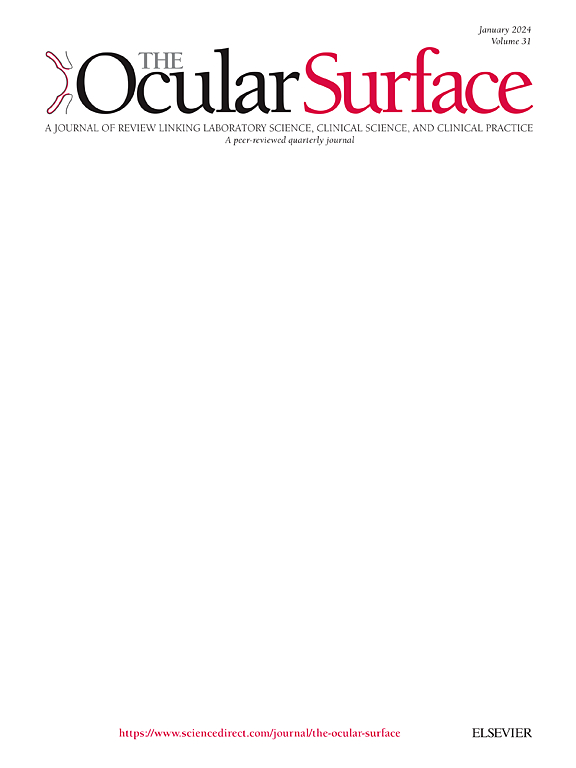Clinical practice patterns in the management of dry eye disease: A TFOS international survey 2023-24
IF 5.6
1区 医学
Q1 OPHTHALMOLOGY
引用次数: 0
Abstract
Aims
To understand current clinical management of dry eye disease (DED), based on its perceived severity and subtype, by practitioners across the world.
Methods
The content of the anonymous survey was chosen to reflect the DED management strategies reported by the Tear Film and Ocular Surface Society (TFOS) second Dry Eye Workshop (DEWS II). Questions were designed to ascertain practitioner treatment choice, depending on the subtype and severity of DED. It was first created in English and then translated/back-translated into 14 languages for online completion.
Results
Completed surveys were received from 905 eye care practitioners (52 % optometrists and 42 % ophthalmologists) from across the globe. Many treatment strategies for DED were observed to be utilised by respondents, independent of severity and subtype, the most common being advice (82 %), low (82 %) and high (81 %) viscosity unpreserved lubricants and lid wipes/scrubs (79 %). Several treatments were prescribed across all severity levels (scaled from 1 mild to 10 severe), such as advice (median 4.5, range 4.8), artificial tears (median 5.1, range 4.6) and nutritional supplements (median 5.3, range 4.2). Others were prescribed more frequently with increasing disease severity, for instance, biologics (median 8.2, range 2.8) and surgical approaches (median 8.1, range 2.2). While a similar number of practitioners reported prescribing advice, artificial tears and anti-inflammatories regardless of DED subtype, the commonly reported approaches for aqueous deficient DED were punctal occlusion, therapeutic contact lenses and secretagogues, while the use of oral essential fatty acids, topical lipid-containing products, lid hygiene and lid warming were the preferred management choices for evaporative DED.
Conclusions
There remains great variability in clinical approaches to DED management and until research-evidence definitively informs improved guidance, data from this survey may be useful for clinicians to benchmark their practice.
干眼病管理的临床实践模式:TFOS国际调查2023-4。
目的:了解目前干眼病(DED)的临床管理,基于其严重程度和亚型被世界各地的从业人员感知。方法:选择匿名调查的内容来反映泪膜和眼表学会(TFOS)第二届干眼研讨会(DEWS II)报告的DED管理策略。根据DED的亚型和严重程度,设计问题以确定医生的治疗选择。它最初是用英语创建的,然后被翻译/反翻译成14种语言供在线完成。结果:收到了来自全球905名眼科医生(52%验光师和42%眼科医生)的完整调查。调查发现,受访者使用了许多治疗DED的策略,与严重程度和亚型无关,最常见的是建议(82%),低(82%)和高(81%)粘度未保存的润滑剂和擦盖/擦洗(79%)。针对所有严重程度(从1轻度到10严重)规定了几种治疗方法,例如建议(中位数4.5,范围4.8),人工泪液(中位数5.1,范围4.6)和营养补充剂(中位数5.3,范围4.2)。随着疾病严重程度的增加,其他药物的使用频率也会增加,例如,生物制剂(中位数8.2,范围2.8)和手术方法(中位数8.1,范围2.2)。尽管类似数量的从业者报告了处方建议、人工泪液和抗炎药,但大多数报告的水缺乏性DED的治疗方法是点状闭塞、治疗性隐形眼镜和分泌剂,而使用口服必需脂肪酸、局部含脂产品、眼睑卫生和眼睑加热是蒸发性DED的首选治疗选择。结论:在DED管理的临床方法中仍然存在很大的差异,在研究证据明确地告知改进的指导之前,临床医生可以使用该调查的数据来基准他们的实践。
本文章由计算机程序翻译,如有差异,请以英文原文为准。
求助全文
约1分钟内获得全文
求助全文
来源期刊

Ocular Surface
医学-眼科学
CiteScore
11.60
自引率
14.10%
发文量
97
审稿时长
39 days
期刊介绍:
The Ocular Surface, a quarterly, a peer-reviewed journal, is an authoritative resource that integrates and interprets major findings in diverse fields related to the ocular surface, including ophthalmology, optometry, genetics, molecular biology, pharmacology, immunology, infectious disease, and epidemiology. Its critical review articles cover the most current knowledge on medical and surgical management of ocular surface pathology, new understandings of ocular surface physiology, the meaning of recent discoveries on how the ocular surface responds to injury and disease, and updates on drug and device development. The journal also publishes select original research reports and articles describing cutting-edge techniques and technology in the field.
Benefits to authors
We also provide many author benefits, such as free PDFs, a liberal copyright policy, special discounts on Elsevier publications and much more. Please click here for more information on our author services.
Please see our Guide for Authors for information on article submission. If you require any further information or help, please visit our Support Center
 求助内容:
求助内容: 应助结果提醒方式:
应助结果提醒方式:


